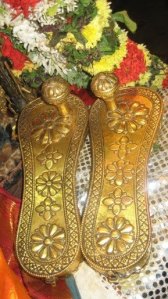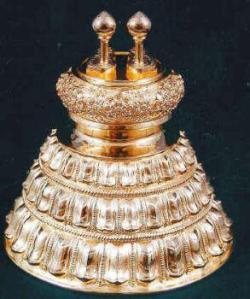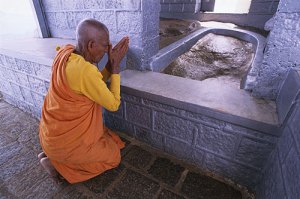
By London swaminathan (Thanks for the pictures: taken from other sites)
“A pair of sandals worn by the Maharishi is expected to fetch £80,000 when they are auctioned later this month. Maharishi Mahesh Yogi shot to fame worldwide as a guru to The Beatles who he first met while he was in London.
He wore the wooden shoes during the height of his fame in the late 1960s and 1970s”-This news item was published by The Daily Mail of London in November 2011. Why do they pay Rs 6,80,00,00 for two sandals?
Why did Bharata, Lord Ram’s brother, keep Rama’s shoes just outside the capital city and ruled the country for 14 years? Why did he place them on the golden throne?
Vedanta Desika, one of the Vaishnavaite Acharyas of Tamil Nadu wrote 1000 slokas on Lords Padukas (shoes)in one night! An amazing feat. Why?
Adi Shankara wrote Guru Paduka Stotra (Hymn on Teacher’s shoes). Why?
Why do we keep great peoples’ shoes in the museum or Ashram?
Why do the Vaishnavaite temples in Tamil Nadu put Lord’s shoes (Satari) on our head after Dharsan ( seeing the God)?
Why do Satya Sai Baba devotees send the shoe replicas of Baba to different towns for Puja?
Why do Tamil Hindus worship shoes of great people like Kanchi Shankaracharya and take replicas home and put them in the Puja room?
Strange Customs?
“ Hindus are a strange race and they have strange customs”—the world may say. No, it is not correct.
Hindus are humble. They see divinity in each and everything. Before stepping out of the bed and putting their feet on the ground, they pray for pardon from the goddess of earth- Bhuma Devi. It is in the Pratasmarana hymn.
Before tilling the land they ask for pardon for digging the earth. Before stepping into water source for bath or cleaning they worship the river or sea. Before eating the food they recite a mantra saying, Oh, You Food , you are god, you are amrita”. In short, for Hindus everything is God. Whether it is music or dance, whether it is the special festival dinner or the Rangoli (Kolam in Tamil) drawn, they see God in it. They feel humble when they think about what God had provided them. They use everything to the minimum and with respect. That is how we see the shoes of God. Once you realise that there is one who is mightier than you, you then behave. You help others by sharing everything God had given you. The Isavasya Upanishad says:
isavasyam idam sarvam yat kinca jagatyam jagat
tena tyaktena bhunjitha ma grdhah kasya svid dhanam
Everything animate or inanimate that is within the universe is controlled and owned by the Lord. One should therefore accept only those things necessary for himself, which are set aside as his quota, and one should not accept other things, knowing well to whom they belong.
A Tamil saint by name Arunagirinathar says the minute Lord Murugan’s (Skanda, Kartikeya in Sanskrit) feet touch his head all the bad Karma will be wiped out. (Tamil verse is given at the end)
A great Tamil Hindu poet Tiruvalluvar praises God’s feet in seven of his first ten couplets in the first chapter (Kadavl Vazthu in Tamil).
Satari In Temples:

Satari is made up of gold or silver or copper with God’s feet on a crown. It is put on every one’s head when one visits Vishnu temples in Tamil Nadu. So Vedanta Desika praised God’s Padukas with one thousand stanzas in his Paduka Sahasra Stotra.
When Rama refused to return to the Kingdom (Ayodhya) saying that he had to fulfil the promise made to his dad, his brother Bharata humbly asked for his shoes. When he took them back, he refused to enter the capital city till his brother return after 14 years. So for 14 years the SHOES RULED A KINGDOM, that was unique in the world.
Worship of Foot Prints

Sivanoli Padam also known as Adam’s Peak in Sri Lanka is a big holy spot. The two foot prints seen there are attributed to Lord Shiva by the Hindus and Buddha by the Buddhists. Thousands of people climb the hills to worship it.
In Kanyakumari, we have Devi’s foot prints. In Haridwar and in the Himalayas we have foot prints of Vishnu.
Foot prints and shoes are sacred symbols for the Hindus. They felt humble and simple in front of little things like shoes or mighty Himalayas. When they looked at sky high mountains they felt like small fries, or like Sir Isaac Newton said, just like pebbles on the vast sea shores. When you feel that way, you get lofty thoughts. All the worries are vanished.
The term Boot Worship in Western Culture has a negative connotation. It is extreme adulation of the boots of a dominant partner. It has got more sexual connotation. In India, it is all about the glory of God.
The very thought that everything is given by the God, will prepare you to share it, respect it and use it to the minimum. This will save the environment and environment will save us in turn.
Satari in Shiva temple
There is a temple in Tirunallur near Papnasam in Tamil Nadu. The Saivaite devotees are blessed with Satari to remember the episode of Shiva blessing the great Saivaite saint Appar 1500 years ago. It looks like this custom has a long history.
Kesaathi Pada Varnanai
Hindu poets sing the glory of God by describing the beauty of god from head to foot. Normally they start with Lord’s feet and goes step by step towards head or hair (Kesa means hair, Pada means foot). If it is human beings like a king or a beautiful girl they start it from the head and go towards foot in description. This is seen in Sangam Tamil literature and earlier Sanskrit literature in several places. So generally speaking Head to foot for the humans and Foot to head for the Gods.
Rig Veda
In the Purusha Suktam of Rig Veda we see the God’s description from face to feet. The hymn described the four varnas (four castes) came from four different parts of the body (of God). This description is about the society. One cannot function without the other. Feet are as important as head.
Sahasra seersha Purusha:………………..
The Purusha has thousand Heads,
He has thousand eyes,
He has thousand feet,
He is spread all over the universe,
And is beyond the count of ten fingers.
Brahmanasya Mukham aseed:…………….
His face became Brahmins
His hands were made as Kshatriyas,
His thighs became Vaisyas,
And from his feet were born Shudras.
Jesus Christ & Washing the feet
Washing the feet of Gurus or Gods is also considered sacred in several cultures. Hindus do it even today with great saints like Shankaracharyas. On certain days children do it to the parents as a mark of respect. On wedding day husband does it to the wife.
The Maundy Thursday custom of foot washing in the catholic church is a symbolic expression of humility, following Christ’s example, who washed the feet of his disciples in accordance with the Eastern custom of hospitality. In ancient India kings washed the feet of holy men’s foot.
Shoes on the head of powerful Tamil King
Cheran Chenguttuvan was a powerful Tamil King. He even insulted the Romans and Greeks who violated the laws of the kingdom by pouring oil on their head. His powerful navy destroyed the pirates. Such a powerful king who went up to the Himalayas to bring stones for the temple, bore the shoes of Lord Shiva on his crown, says the Tamil epic Silaappadikaram( Kaalkot Kaathai 8)
In China
The mother of the founder of the Chou dynasty was said to have become pregnant by stepping in the foot print of a god.
சேல் பட்டழிந்தது செந்தூர் வயற்பொழில் தேங்கடம்பின்
மால் பட்டழிந்தது பூங்கொடியார் மனம் மாமயிலோன்
வேல் பட்டழிந்தது வேலையும் சூரனும் வெற்புமவன்
கால் பட்டழிந்தது இங்கென் தலை மேல் அயன் கை எழுத்தே
------(கந்தர் அலங்காரம்)
For more of the same, contact [email protected] OR [email protected]
*******************
